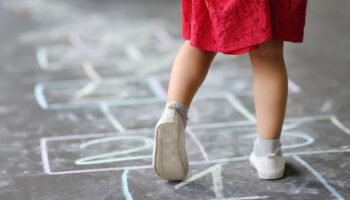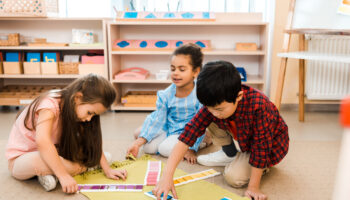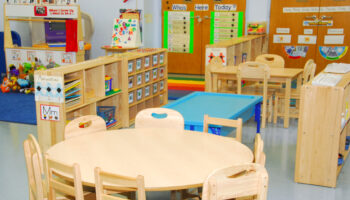By Bobbi Philson
Is it an interest center? Is it a play area? Is it both? Does it matter?
A play area needs:
- Play materials
- Space
An interest center needs:
- Clear definition
- Materials for a particular kind of play
- Materials organized by type and accessible to children
- Furniture if needed
- Appropriate space for the type of play and the number of children allowed
What interest centers should be set up and what should I put in the centers?
Cozy area
- Substantial amount of softness
- Separated from noisy areas
Reading center
- Place to store the books that encourages book use (covers easily seen)
- Space with comfortable furnishing
- Separated from noisy areas
Block Center
- Unit blocks and/or hollow blocks
- Accessories
- Small people, vehicles, animals
- More examples: road signs, fences, trees, small buildings
Dramatic Play Center
- Housekeeping props:
- Dolls
- Child sized furniture
- Play foods and cooking/eating utensils
- Dress-up clothes for boys and girls
- Props for different kinds of work
- Uniforms, equipment associated with different kinds of work
- Fantasy
- Costumes and props
- Leisure
- Examples: camping or sports
Nature/science Center
- Living things
- Plants or pets
- Natural objects
- Examples: bird nests, leaves, rocks, shells, seeds
- Factual books (at least 5)
- Nature-science picture games
- Tools
- Examples: magnets, magnifying glasses, microscopes, color viewers
- Sand or water play (does not have to be physically in the center)
There are additional interest centers you may want to set up in your classroom, including but not limited to:
- Art
- Fine Motor
- Math
- Writing
- Music
Materials to support art exploration, fine motor skill development, math/number learning, and music/movement are expected in the ECERS-3 and one way to include those materials would be in interest centers, but it’s possible that some of these materials could be combined to form play areas.
Remember when setting up interest centers, that they are defined as specific, clearly distinguished types of play areas. Think about the purpose of the interest center being established. For example, the purpose of the block area is to encourage the use of the blocks to build structures. The accessories are to give children ideas for structures to build (roads and garages for cars, barns and zoos for animals, houses for people). Therefore, a block interest center includes only unit blocks and/or hollow blocks and accessories (such as people, cars, road signs, animals).
As centers and play areas are established, remember to make them large enough to accommodate the teacher and the number of children permitted in the center. Teachers can’t engage with children in play, expanding and extending their language, and introducing math and science concepts if they can’t fit into the space. Poet/scholar Mark Doren said, “The art of teaching is the art of assisting discovery.” So use those centers wisely, get in there, and help kids discover!




